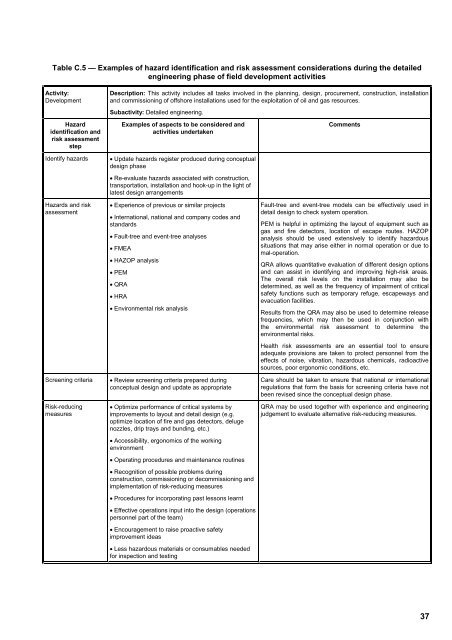ISO 17776 Checklist
ISO 17776 Checklist
ISO 17776 Checklist
Create successful ePaper yourself
Turn your PDF publications into a flip-book with our unique Google optimized e-Paper software.
Table C.5 — Examples of hazard identification and risk assessment considerations during the detailed<br />
engineering phase of field development activities<br />
Activity:<br />
Development<br />
Description: This activity includes all tasks involved in the planning, design, procurement, construction, installation<br />
and commissioning of offshore installations used for the exploitation of oil and gas resources.<br />
Subactivity: Detailed engineering.<br />
Hazard<br />
identification and<br />
risk assessment<br />
step<br />
Identify hazards<br />
Hazards and risk<br />
assessment<br />
Screening criteria<br />
Risk-reducing<br />
measures<br />
Examples of aspects to be considered and<br />
activities undertaken<br />
Update hazards register produced during conceptual<br />
design phase<br />
Re-evaluate hazards associated with construction,<br />
transportation, installation and hook-up in the light of<br />
latest design arrangements<br />
Experience of previous or similar projects<br />
International, national and company codes and<br />
standards<br />
Fault-tree and event-tree analyses<br />
FMEA<br />
HAZOP analysis<br />
PEM<br />
QRA<br />
HRA<br />
Environmental risk analysis<br />
Review screening criteria prepared during<br />
conceptual design and update as appropriate<br />
Optimize performance of critical systems by<br />
improvements to layout and detail design (e.g.<br />
optimize location of fire and gas detectors, deluge<br />
nozzles, drip trays and bunding, etc.)<br />
Accessibility, ergonomics of the working<br />
environment<br />
Operating procedures and maintenance routines<br />
Recognition of possible problems during<br />
construction, commissioning or decommissioning and<br />
implementation of risk-reducing measures<br />
Procedures for incorporating past lessons learnt<br />
Effective operations input into the design (operations<br />
personnel part of the team)<br />
Encouragement to raise proactive safety<br />
improvement ideas<br />
Less hazardous materials or consumables needed<br />
for inspection and testing<br />
Comments<br />
Fault-tree and event-tree models can be effectively used in<br />
detail design to check system operation.<br />
PEM is helpful in optimizing the layout of equipment such as<br />
gas and fire detectors, location of escape routes. HAZOP<br />
analysis should be used extensively to identify hazardous<br />
situations that may arise either in normal operation or due to<br />
mal-operation.<br />
QRA allows quantitative evaluation of different design options<br />
and can assist in identifying and improving high-risk areas.<br />
The overall risk levels on the installation may also be<br />
determined, as well as the frequency of impairment of critical<br />
safety functions such as temporary refuge, escapeways and<br />
evacuation facilities.<br />
Results from the QRA may also be used to determine release<br />
frequencies, which may then be used in conjunction with<br />
the environmental risk assessment to determine the<br />
environmental risks.<br />
Health risk assessments are an essential tool to ensure<br />
adequate provisions are taken to protect personnel from the<br />
effects of noise, vibration, hazardous chemicals, radioactive<br />
sources, poor ergonomic conditions, etc.<br />
Care should be taken to ensure that national or international<br />
regulations that form the basis for screening criteria have not<br />
been revised since the conceptual design phase.<br />
QRA may be used together with experience and engineering<br />
judgement to evaluate alternative risk-reducing measures.<br />
37


